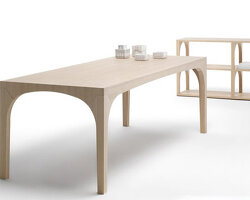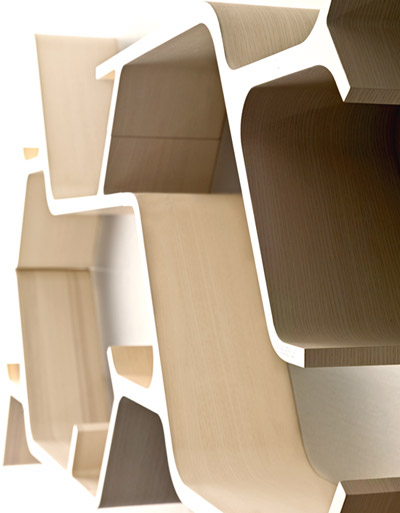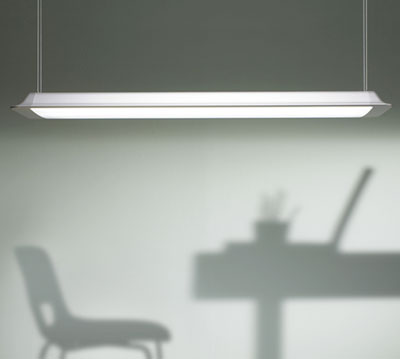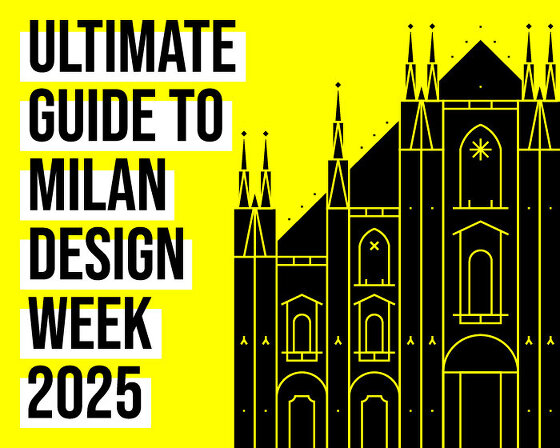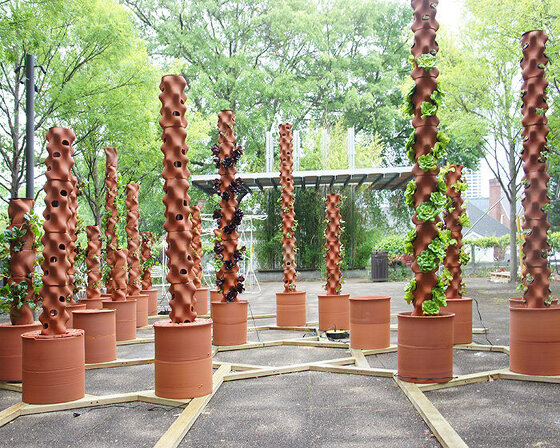instead of being held within zona tortona, the design academy eindhoven‘s presentation at milan design week 2010 was held in milan’s lambrate area. co-curated by ilse crawford (british designer and head of the design department ‘man and well being’), and anne mieke eggenkamp (chairwoman of the design academy eindhoven), the show was comprised of the most recent work of the academy’s graduate students.
the exhibition was entitled ‘questions’ in which the graduates raised questions about a variety of issues, researching and finding answers / solutions, presented in the form of design solutions.
‘morning glory’ by wendy legro image © designboom
‘can design help us reconnect with our biorhythms?‘ because we use so much artificial light, we have lost touch with our biorhythms. with ‘morning glory’, wendy legro wants to reintroduce the sun’s natural source of light back into our lives. ‘morning glory’ consists of mechanical flowers which are triggered by a light sensor. by day, the flowers are closed, allowing the sun to shine in, and after sunset they open up and radiate light as they begin to cover the window.
 detail image © designboom
detail image © designboom
 installation view image © designboom
installation view image © designboom
 image © designboom
image © designboom
 up close image © designboom
up close image © designboom
 mechanism image © designboom
mechanism image © designboom
 ‘mark the last veil’ by roos kuipers photo by rené van der hulst
‘mark the last veil’ by roos kuipers photo by rené van der hulst
designer roos kuipers asked: ‘how can we make the last goodbye to a loved died a tender moment?‘closing a coffin is a harsh, abrupt action that is ill-suited to the sensitive and emotional process of grieving. so, he designed ‘mark the last veil’, a bier with softer, rounder shapes. when saying their last good-byes, the bereaved can cover their lost one with six layers of transparent cloth, one at a time, slowly veiling the image of the deceased. fastening each layer of cloth into a groove in the side, they can lovingly tuck in the deceased with the utmost care
 the bier unveiled image © designboom
the bier unveiled image © designboom
 ‘curiosity cabinet’ by jon stam image © designboom
‘curiosity cabinet’ by jon stam image © designboom
‘can a sixteenth-century curiosity cabinet be transposed to our times?‘ jon stam has created a cabinet that incorporates the tensions between the physical and the virtual world. within, there is room for physical objects and digital data to be stored on memory sticks and RFID tags. in order to stress the weightlessness and the immaterial character of the virtual space, he has left his digital boxes hollow and embedded the sticks and tags in the wood.
 a view inside the cabinet’s compartments image © designboom
a view inside the cabinet’s compartments image © designboom
 ‘curiosity cabinet’ by jon stam photo by rené van der hulst
‘curiosity cabinet’ by jon stam photo by rené van der hulst
 ‘a human measure’ by digna kosse image © designboom
‘a human measure’ by digna kosse image © designboom
‘how can our measurements connect to the resources we use?‘ ‘is our use of resources still in proportion to our own measurements in relation to the world?‘ digna kosse believes our consumerism has grown out of proportion. she has sought to find a way of visualizing an exact human measure. using water, she has determined the volume of her own body parts and taken this as a measure for a series of 25 bowls. the largest bowl shows the volume of her torso, the smallest one represents her little toe. if you were to fill each bowl with food, you would be eating an entire body.
 up close image © designboom
up close image © designboom



